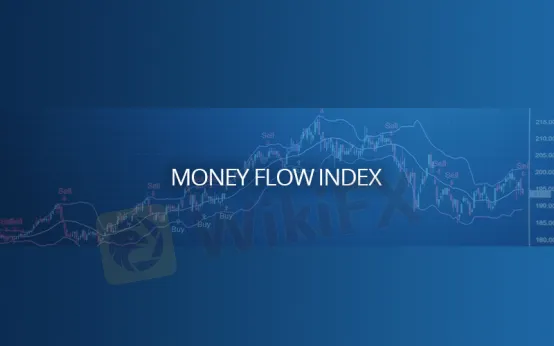简体中文
繁體中文
English
Pусский
日本語
ภาษาไทย
Tiếng Việt
Bahasa Indonesia
Español
हिन्दी
Filippiiniläinen
Français
Deutsch
Português
Türkçe
한국어
العربية
How to Use the Money Flow Index Indicator to Make Money in Forex
Abstract:The money flow index indicator is a sophisticated technical indicator that can be found in most Forex trading systems for free. For an easy-to-read visual depiction of momentum, it is plotted immediately on a price chart. A good Forex trading strategy may be built on trading with high market momentum. In this post, I've taken a deeper look at the money flow index indication to help you determine whether you should use it in your trading as you strive to become a more lucrative Forex trader.

The money flow index indicator is a sophisticated technical indicator that can be found in most Forex trading systems for free. For an easy-to-read visual depiction of momentum, it is plotted immediately on a price chart. A good Forex trading strategy may be built on trading with high market momentum. In this post, I've taken a deeper look at the money flow index indication to help you determine whether you should use it in your trading as you strive to become a more lucrative Forex trader.
What is the Money Flow Index Indicator, and how does it work?
The money flow index indicator (MFI) is a single numerical output oscillator and momentum indicator that ranges from 0 to 100. 100 is the maximum bullish (upwards) momentum value, whereas 0 represents the highest bearish (downwards) momentum number.
The MFI is frequently referred to as a volume-weighted Relative Strength Index. The MFI's exact computation will be discussed later in this text. It determines the intensity of momentum at any particular time by combining price and volume, two of the most definite aspects of technical analysis. The MFI is commonly used by forex traders to spot positive and negative divergences between the indicator value and price movement, as well as to fade (trade a reversal) overbought (above 80) or oversold (below 20) levels.
However, in Forex, buying or selling only based on the value of an indicator applied to a particular time frame is a money flow index technique that I do not suggest since it is never lucrative in the long run. The MFI is better utilized in more advanced methods, which I'll discuss later in this essay.
Because the MFI relies on volume and the Forex market is decentralized, precise volume data is usually difficult to come by. Forex traders will find it more difficult to use the MFI than equities traders, who have access to clear volume data. Some Forex firms are now offering real-time volume data, although this data only includes the broker's internal flow or volume data from their liquidity providers, and does not represent the whole market.
To compute the volume element, money flow index indicators integrated into or added as plugins to the MetaTrader 4 or MetaTrader 5 trading platforms employ tick volume. Because a few Forex companies provide their own volume data, certain versions of the MFI indicator that use the broker's data can be found, however these can be difficult to discover. Volume data is available for currency pair futures traded over the counter on major US exchanges, which is a third alternative that is not widely addressed. This allows you to use the MFI indicator with data from currency futures while trading the spot Forex equivalent of the MFI indicator data supplied by the relevant currency future. Although futures are only accessible on a restricted number of currency pairings, principally the majors, this can work well if you can set it up.

How to Use the Money Flow Index Indicator (MFI)
I will start by discussing the three types of trading signals the MFI can generate. Before using any technical indicator, I always stress the importance of understanding what indicators can tell traders about price action. Many new traders rush into using indicators without knowing how to apply them effectively. They rely on the simplest principles, which I want to note again, do not generate consistent profits. Otherwise, the retail loss rate of Forex traders would not range between 70% and 85% at most major Forex brokerages.
Here are the three types of trading signals that MFI provides:
1. Oversold and Overbought Levels: When the MFI moves below 20, traders consider the asset oversold. An overbought condition occurs with the MFI above 80. They are the most direct trading signals from the MFI but also the least reliable. Shorter time frames, for example, the M5 or M15 charts, will get more readings below 20 and above 80. The drawback remains reduced reliability. I prefer the MFI on the H1 chart, a middle ground between frequency and accuracy. Some traders wait for the MFI to break out or break down above and below 20 and 80 before entering a trend, as it may suggest the correction or sell-off is near the end, with volume flowing into the asset for a trend reversal.
2. Positive and Negative Divergences: I prefer to trade divergences because, in my opinion, they produce the most dependable trading signals. When price action makes a lower low while the MFI or another indicator makes a higher low, this is known as a positive divergence. When price action makes a higher high while the indicator makes a lower high, a negative divergence occurs. Failure swings, the MFI's third trading signal, provide confirmation for positive and negative divergences.
3. Bullish and Bearish Failure Swings: While positive and negative divergences are still good trading signals, I like to double-check them with bullish and bearish failure swings. You'll miss out on some of the pricing activity, but your dependability will improve significantly. When the MFI drops below 20, then reverses above it, corrects from its peak but maintains above 20, and then accelerates to a higher high, it is considered a bullish failure swing. After the MFI advances above 80, it slips below it before rising but sustaining its position below 80 before crashing to a lower low.
The Money Flow Index Indicator and How to Calculate It (MFI)
The money flow index indicator is calculated automatically by the MT4 and MT5 trading platforms. Despite this, I usually advise traders to grasp how the computations operate in order to have a better understanding of the MFI. Traders that know how to manually plot the MFI, including the calculations, will have a higher success rate when employing it.
1. Calculate the typical price by adding the high, low, and close. Then divide it by three.
2. Calculate the money flow by multiplying the typical price by volume. If the current price is above the previous one, it is known as positive money flow. If the current price is below the previous one, it is known as negative money flow.
3. Calculate the money flow ratio by dividing the 14-period positive money flow by the 14-period negative money flow. Positive money flow is the sum of positive money over the past fourteen days, and negative money flow is the sum of negative money.
4. Calculate the money flow index indicator using the formula: 100 - 100/ (1 + money flow ratio).
The MFI can provide solid trading indications, but it is not a holy grail for traders. Positive and negative divergence signals, validated by bullish and bearish failure swings, are the greatest way to develop trade entry ideas. I also recommend combining the MFI with at least one other indication and at least one other time period, with the lower time frame being no lower than the hourly (H1).

Disclaimer:
The views in this article only represent the author's personal views, and do not constitute investment advice on this platform. This platform does not guarantee the accuracy, completeness and timeliness of the information in the article, and will not be liable for any loss caused by the use of or reliance on the information in the article.
Read more

Inzo Broker Review 2025: Is It Legit or a High-Risk Gamble?
When you ask, "Is inzo broker legit?" you want a clear, straight answer before putting your money at risk. The truth about Inzo Broker is complicated. Finding out if it's legitimate means looking carefully at its rules, trading setup, and most importantly, the real experiences of traders who have used it. The broker shows a mixed picture - it has official paperwork from an offshore regulator, but it also has many user warnings about how it operates. This review gives you a fair and fact-based investigation. We will break down all the information we can find, from company records to serious user complaints, so you can make your own clear decision.

Uniglobe Markets Review 2025: A Complete Guide to an Unregulated Broker
Uniglobe Markets claims to be an online trading company that offers many different types of investments, including foreign currency and raw materials. The company tries to attract traders by offering high leverage, different account options, and popular MetaTrader trading software. However, there is one major problem: the company does not have proper regulatory oversight. This creates serious concerns about the safety of clients’ capital and whether the company operates honestly. Read on to learn more about its regulatory status.

The 5%ers Review: Is it a Scam or Legit? Find Out from These Trader Comments
Did you face reduced leverage and hiked fees without any explanation from The 5%ers broker? Do you find The 5%er rules strange for getting a funded account from this prop trading firm? Has the broker closed your trade inappropriately, preventing you from making gains in the forex market? All these allegations have dominated The 5%ers review segment online. Looking at this, the WikiFX team investigated and found some startling comments against the broker. In this article, we have shared those complaints. Read on!

Inzo Broker Review 2025: A Complete Look at Features, Costs and User Claims
Inzo Broker presents itself as a modern forex and CFD broker, started in 2021 and registered in Saint Vincent and the Grenadines. At first glance, it offers an attractive package for traders: access to the popular MetaTrader 5 (MT5) and cTrader platforms, different types of accounts for various budget levels, and a wide selection of assets to trade. These features are made to attract both new and experienced traders. However, a closer look shows a big difference between these advertised benefits and the real risks. The broker works under an offshore regulatory system, which gives limited protection to investors. More importantly, Inzo has collected many serious user complaints, especially about withdrawing funds and changing trading conditions unfairly. This mix of weak oversight and serious user claims creates a high-risk situation that potential clients must carefully think about. This review will break down these parts to give a clear, fact-based view.
WikiFX Broker
Latest News
Is Fyntura a Regulated Broker? A Complete 2025 Broker Review
Zetradex Exposed: Withdrawal Denials, Account Freeze & Bonus Issues Hurt Traders
Is Forex Zone Trading Regulated and Licensed?
PINAKINE Broker India Review 2025: A Complete Guide to Safety and Services
Exness Restricted Countries List 2025 Explained
Is Uniglobe Markets Legit? A 2025 Simple Guide to Its Safety, Services, and User Warnings
Is Inzo Broker Safe or a Scam? An Evidence-Based Analysis for Traders
WikiEXPO Dubai 2025 “Welcome Party” Kicks Off Tonight!
He Trusted a WhatsApp Group and Lost RM659,000
Moomoo Singapore Opens Investor Boutiques to Strengthen Community
Currency Calculator




